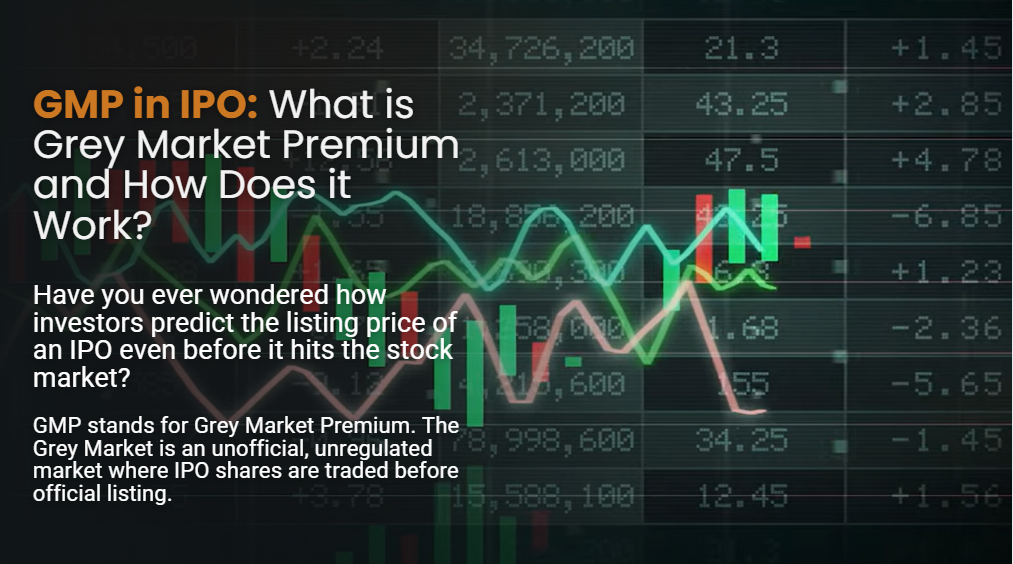grow your investment.
GMP in IPO: What is Grey Market Premium and How Does it Work?
Have you ever wondered how investors predict the listing price of an IPO even before it hits the stock market? Or how do some people make profits even before the IPO gets listed? The answer lies in GMP in IPO, also known as grey market premium.
In this article, we will explain what GMP in IPO means, how it works, what are its advantages, limitations, and how investors should use it while making investment decisions. If you are planning to invest in an IPO, it is extremely important to understand GMP.
What is GMP in IPO?
GMP stands for Grey Market Premium. The Grey Market is an unofficial, unregulated market where IPO shares are traded before official listing.
Example: Suppose a company issues its IPO at ₹100 per share, and the GMP in the grey market is ₹50. This indicates that the stock may list around ₹150.
But how is this possible when the IPO isn’t even listed yet? In the grey market, people trade on the basis of future delivery promises. If I get allotment at ₹100, I promise to sell it to someone at ₹150. This market is completely unofficial, without SEBI regulations or legal framework—only trust and word of mouth drive it.

How Does GMP in IPO Work?
The movement of GMP in IPO depends on demand and supply, investor sentiment, and subscription numbers.
At IPO Announcement: Grey market players set the initial GMP based on demand-supply expectations. Institutional and HNI (High Net-Worth Individual) investors’ interest also influences it.
During IPO Application Period: GMP keeps fluctuating according to subscription status and market mood.
-Real Example: Zomato IPO was priced at ₹76. Its GMP fluctuated between ₹7–₹16 before rising to ₹18–₹22 just before listing. GMP predicted around a 24–29% premium, but Zomato actually listed with a 52.6% premium.
-Negative GMP: A negative GMP indicates that the stock is expected to list below the issue price.
Advantages of GMP in IPO.
1. Initial market sentiment
High GMP = positive sentiment; low/negative GMP = market caution.
2. Risk assessment tool
A consistently low or fluctuating GMP indicates uncertainty about the company’s valuation.
3. Exit strategy planning
If allotment is received and GMP is high, investors can plan for listing gains.
Example: Paytm’s IPO at ₹2,150 had a negative GMP of ₹30. The stock actually listed at ₹1,950—a loss of 9%. The GMP triggered an early warning.
Limitations of GMP in IPO.
While GMP in IPO is useful, it has several drawbacks:
Unofficial and Unregulated – No guarantee of delivery, as the grey market has no legal framework.
Manipulation Possible – Big players can artificially inflate GMP to create fake hype.
Limited Liquidity – Only a small number of participants exist, making conclusions risky.
Over-Reliance by Retail Investors – Many apply only based on GMP without analyzing fundamentals, which is a wrong approach.
How to Use GMP in IPO for Investment Decisions.
Here’s a practical framework:
Combine GMP with Fundamentals – Never rely solely on GMP. Check the company’s business model, financials, industry prospects.
Analyze GMP Trend – Look at GMP movement over 7–10 days, not just one day. Consistent trends are more reliable than sudden spikes.
Industry Comparison – Compare GMP of recent IPOs in the same sector with their actual performance.
Framework:
High GMP + Strong Fundamentals = Consider Applying
High GMP + Weak Fundamentals = Be Cautious
Low/Negative GMP + Strong Fundamentals = Hidden Opportunity (Maybe)
Low/Negative GMP + Weak Fundamentals = Avoid
Key Takeaways on GMP in IPO
GMP is a helpful tool but not a magic formula.
Always combine GMP with proper company research.
GMP fluctuates constantly; timing matters.
Never invest only based on GMP. Do your own due diligence.
Conclusion
GMP in IPO (Grey Market Premium in IPO) is an early indicator of investor sentiment and expected listing gains. While it provides useful insights, it is unofficial, unregulated, and prone to manipulation. Smart investors should use it as just one of many data points, along with thorough research on the company’s fundamentals.
Recommended

All Time Plastics IPO Review |
IPO GMP, Analyst Ratings,
Business and more.
All time plastics company that manufactures
plastic consumer goods....

Best Mutual Funds 2025 India:
A Data-Backed Guide.
We spent 7 months analyzing over 1500
mutual funds across 50+ parameters...

How to Create BEST Mutual
Fund PORTFOLIO 2025?
When it comes to building wealth through
mutual funds, one of the most common...

What Are ETFs and Why They
Might Be Better Than
Mutual Funds?
In recent years, the popularity of ETFs
(Exchange-Traded Funds) in India has...

Top AI Stocks in India To watch
in 2025.
In today’s discussion, we will look at the
top five AI (Artificial Intelligence) ...
Related Articles


